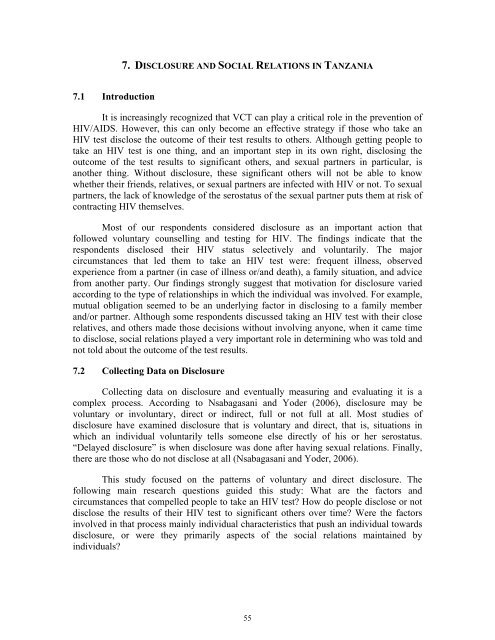social context of disclosing hiv test results: hiv testing in tanzania
social context of disclosing hiv test results: hiv testing in tanzania
social context of disclosing hiv test results: hiv testing in tanzania
Create successful ePaper yourself
Turn your PDF publications into a flip-book with our unique Google optimized e-Paper software.
7.1 Introduction<br />
7. DISCLOSURE AND SOCIAL RELATIONS IN TANZANIA<br />
It is <strong>in</strong>creas<strong>in</strong>gly recognized that VCT can play a critical role <strong>in</strong> the prevention <strong>of</strong><br />
HIV/AIDS. However, this can only become an effective strategy if those who take an<br />
HIV <strong>test</strong> disclose the outcome <strong>of</strong> their <strong>test</strong> <strong>results</strong> to others. Although gett<strong>in</strong>g people to<br />
take an HIV <strong>test</strong> is one th<strong>in</strong>g, and an important step <strong>in</strong> its own right, <strong>disclos<strong>in</strong>g</strong> the<br />
outcome <strong>of</strong> the <strong>test</strong> <strong>results</strong> to significant others, and sexual partners <strong>in</strong> particular, is<br />
another th<strong>in</strong>g. Without disclosure, these significant others will not be able to know<br />
whether their friends, relatives, or sexual partners are <strong>in</strong>fected with HIV or not. To sexual<br />
partners, the lack <strong>of</strong> knowledge <strong>of</strong> the serostatus <strong>of</strong> the sexual partner puts them at risk <strong>of</strong><br />
contract<strong>in</strong>g HIV themselves.<br />
Most <strong>of</strong> our respondents considered disclosure as an important action that<br />
followed voluntary counsell<strong>in</strong>g and <strong>test</strong><strong>in</strong>g for HIV. The f<strong>in</strong>d<strong>in</strong>gs <strong>in</strong>dicate that the<br />
respondents disclosed their HIV status selectively and voluntarily. The major<br />
circumstances that led them to take an HIV <strong>test</strong> were: frequent illness, observed<br />
experience from a partner (<strong>in</strong> case <strong>of</strong> illness or/and death), a family situation, and advice<br />
from another party. Our f<strong>in</strong>d<strong>in</strong>gs strongly suggest that motivation for disclosure varied<br />
accord<strong>in</strong>g to the type <strong>of</strong> relationships <strong>in</strong> which the <strong>in</strong>dividual was <strong>in</strong>volved. For example,<br />
mutual obligation seemed to be an underly<strong>in</strong>g factor <strong>in</strong> <strong>disclos<strong>in</strong>g</strong> to a family member<br />
and/or partner. Although some respondents discussed tak<strong>in</strong>g an HIV <strong>test</strong> with their close<br />
relatives, and others made those decisions without <strong>in</strong>volv<strong>in</strong>g anyone, when it came time<br />
to disclose, <strong>social</strong> relations played a very important role <strong>in</strong> determ<strong>in</strong><strong>in</strong>g who was told and<br />
not told about the outcome <strong>of</strong> the <strong>test</strong> <strong>results</strong>.<br />
7.2 Collect<strong>in</strong>g Data on Disclosure<br />
Collect<strong>in</strong>g data on disclosure and eventually measur<strong>in</strong>g and evaluat<strong>in</strong>g it is a<br />
complex process. Accord<strong>in</strong>g to Nsabagasani and Yoder (2006), disclosure may be<br />
voluntary or <strong>in</strong>voluntary, direct or <strong>in</strong>direct, full or not full at all. Most studies <strong>of</strong><br />
disclosure have exam<strong>in</strong>ed disclosure that is voluntary and direct, that is, situations <strong>in</strong><br />
which an <strong>in</strong>dividual voluntarily tells someone else directly <strong>of</strong> his or her serostatus.<br />
“Delayed disclosure” is when disclosure was done after hav<strong>in</strong>g sexual relations. F<strong>in</strong>ally,<br />
there are those who do not disclose at all (Nsabagasani and Yoder, 2006).<br />
This study focused on the patterns <strong>of</strong> voluntary and direct disclosure. The<br />
follow<strong>in</strong>g ma<strong>in</strong> research questions guided this study: What are the factors and<br />
circumstances that compelled people to take an HIV <strong>test</strong>? How do people disclose or not<br />
disclose the <strong>results</strong> <strong>of</strong> their HIV <strong>test</strong> to significant others over time? Were the factors<br />
<strong>in</strong>volved <strong>in</strong> that process ma<strong>in</strong>ly <strong>in</strong>dividual characteristics that push an <strong>in</strong>dividual towards<br />
disclosure, or were they primarily aspects <strong>of</strong> the <strong>social</strong> relations ma<strong>in</strong>ta<strong>in</strong>ed by<br />
<strong>in</strong>dividuals?<br />
55

















